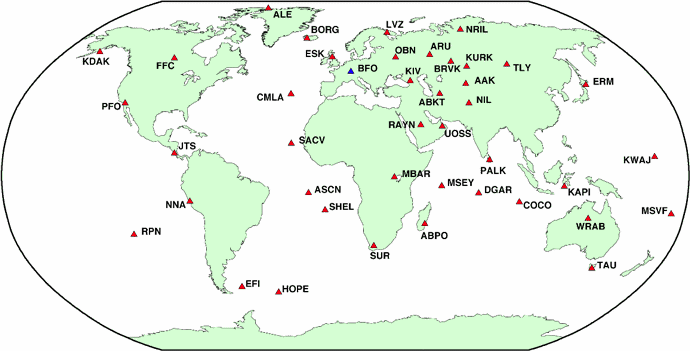IRIS/IDA Data Collection Center
The IRIS/IDA Data Collection Center is operated by Project IDA and the Cecil H. and Ida M. Green Institute of Geophysics and Planetary Physics of the University of California, San Diego. The DCC is located within facilities belonging to IGPP on the campus of the Scripps Institution of Oceanography in La Jolla, California. IDA has had a relationship with IRIS dating to IRIS’ inception.
History
The original network operated by Project IDA from 1975-1995 was a global network of digitally recorded La Coste gravimeters that measured earth motion at very long periods. The concept of the IDA La Coste network grew out of two developments of the late 1960s. Studies of the earth’s normal modes showed that they could provide valuable constraints on earth structure and earthquake mechanisms, but a shortage of data limited further progress. During the same period, low-noise feedback seismometers were developed that allowed such data to be obtained from relatively small (and hence frequent) earthquakes. A complete description of the original IDA network can be found in Eos (April 22, 1986, vol. 67, no. 16, pages 203-212).
After IRIS came into existence, IDA was chosen as one of two network operators for the IRIS Global Seismic Network (GSN). Beginning with then extant IDA network of La Coste instruments and taking advantage of political developments in the Soviet Union, IRIS/IDA quickly deployed several additional stations in areas of keen interest to Western scientists. The IDA portion of the IRIS GSN has continued to expand so that the IRIS/IDA DCC now processes data from 37 stations in 22 countries, with several more to be completed shortly.

Data Collection
The IDA DCC is responsible for receiving, logging, and unpacking all data from IRIS/IDA GSN stations, performing quality control and routinely reviewing data to assess station performance, reformatting all data, and distributing data in a timely manner via the IRIS Data Management System. On a weekly basis, DCC personnel process one DAT tape per station, each containing approximately 1 Gbyte of raw data. After the data are read onto disk, DCC personnel assess the quality of the recording, and in particular, search for evidence of any mistiming of the waveforms and clues that either the sensors or the data logging equipment at the recording site have malfunctioned. Any detected problems are noted and brought to the attention of the GSN operations staff, who are responsible for correcting the source of the problem. All data that pass the quality assessment tests are then transcribed into SEED format and transmitted daily to the IRIS DMC in Seattle for distribution to the user community. On a non-routine basis, DCC personnel also track changes in instrumentation and calibration that occur during normal maintenance of the network. This information is encoded into SEED and transmitted to the DMC as needed, over intervals of approximately one month.
by Pete Davis (IRIS/IDA)






